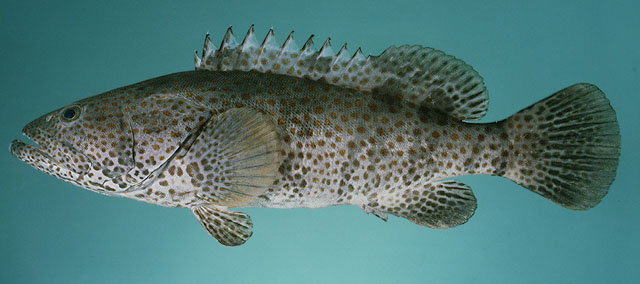| Serranidae (Sea basses: groupers and fairy basslets), subfamily: Epinephelinae |
| 120 cm TL (male/unsexed); max.weight: 15 kg; max. reported age: 22 years |
|
reef-associated; depth range 1 - 100 m |
| Indo-West Pacific: Red Sea south to at least Durban, South Africa and eastward to Palau and Fiji, north to the Ryukyu Islands, south to the Arafura Sea (Ref. 9819) and Australia. Recently reported from the Mediterranean coast of Israel (Ref. 5222). Frequently misidentified as Epinephelus tauvina or Epinephelus malabaricus (Ref. 27362). |
|
Dorsal spines (total): 11-11; Dorsal soft rays (total): 13-16; Anal spines: 3-3; Anal soft rays: 8-8. Small individuals closely resemble E. tauvinaand E. malabaricus, but have orange spots and lack hexagonal spots on the fins (Ref. 37816); head and body tan dorsally, shading to whitish ventrally; numerous small brownish orange or reddish brown spots on head, body and median fins (Ref. 89707); further characterized by having overall tan color; four irregular H-shaped dark bars; back with 3-4 blackish saddles; head, body and fins with numerous small brownish orange or reddish brown spots; body scales ctenoid except for nape, back, thorax, abdomen and above anal-fin base with cycloid scales; greatest depth of body 2.9-3.7 in SL; rounded caudal fin; short pelvic fins, 1.9-2.7 in head length (Ref. 90102). |
| Inhabit turbid coastal reefs (Ref. 9710) and are often found in brackish water (Ref. 27362) over mud and rubble (Ref. 6390). Solitary (Ref 90102). Juveniles are common in shallow waters of estuaries over sand, mud and gravel and among mangroves (Ref. 6390). Feed on small fishes, shrimps, and crabs. Probably spawn during restricted periods and form aggregations when doing so (Ref. 27352). Eggs and early larvae are probably pelagic (Ref. 6390). Has been tested in several countries as a potential species for mariculture (Ref. 43448). |
|
Near Threatened
(Ref. 96402)
, IUCN Grouper and Wrasse Specialist Group
|
| harmless |
|
Source and more info: www.fishbase.org. For personal, classroom, and other internal use only. Not for publication.
Page created by Jen, 05.08.02,
php script by kbanasihan 06/09/2010 ,
last modified by
dsantos, 20/08/10

